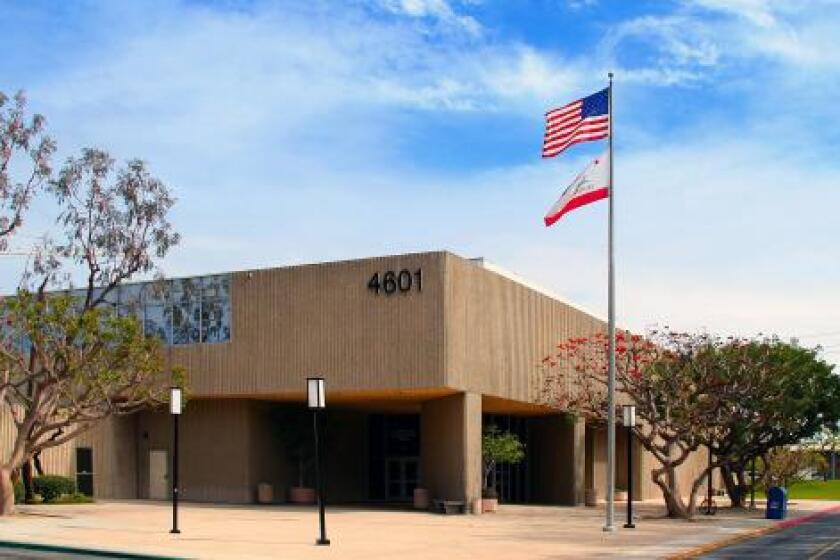A large ship for the harbor
- Share via
John Blaich
At high tide on the morning of Nov. 15, 1945, the USS Hale (DD642)
entered Newport Harbor. She was and still is the largest vessel ever to
enter the harbor.
When the Pacific fleet returned to the West Coast at the end of World
War II, all of the ship repair facilities at San Pedro and Long Beach
were inundated with work. South Coast Shipyard had open time. Thus, Hale
was taken to Newport Harbor for repairs that did not require dry docking
the ship. A six-week availability was scheduled.
Hale, a 2,100-ton Fletcher Class destroyer, was 376 feet, 6 inches
long, with a beam of 39 feet, 7 inches and a draft of 13 feet when fully
loaded. Her ammunition had been removed at the Seal Beach Naval
Ammunition depot.
The fuel-water ballast tanks probably had been emptied, so the draft
as she entered the harbor may have been 12 feet, 9 inches. The depth at
mean low tide in the main ship channel was then 20 feet. The high tide on
that morning was 5.1 feet, so the average depth under the keep was about
12 feet, 3 inches if Hale stayed in the main ship channel. Twelve feet of
water under the keep does not allow for much margin of error, not to
mention the fact that a ship does not respond well to rudder movements
when operating in shallow water.
Robert L. Boyd, a local yachtsman who was employed by the South Coast
Shipyard, boarded Hale at the Bell Bouy from the tug boat Walrus and
acted as the harbor pilot.
The destroyer proceeded slowly up the harbor to pilings that were
placed at the edge of the main ship channel where the Balboa Bay Club is
now located. She was moored “starboard side to” these pilings or
dolphins.
The Hale was built by the Bath Iron Works at Bath, Maine, in 1943. She
was commissioned at Boston on June 15, 1943 and immediately began a very
active wartime career.
She arrived at Pearl Harbor in October 1943. Hale took part in several
invasions in the Pacific. She was assigned escort duty with the
battleship/cruiser shore bombardment task forces operating off Japan.
Hale was awarded seven battle stars for the Pacific campaigns and two
battle stars for the Philippine liberation campaign.
Hale was a “lucky ship” during two years of hostile action against the
enemy -- she was never hit.
During Hale’s visit at Newport Harbor, various civic groups were given
tours. On Jan. 10, 1946, 37 grammar school students were given a complete
tour of the ship by Lt. Henry Lapkin, the communications officer, as a
reward for selling war bonds.
At that time, Balboa was the center of recreational activities. At the
Pavilion, you could bowl, the Rendezvous Ballroom was open on weekends
and there was Christians Hut for fine dining. Whites Cafe, Guss’s Shell
Cafe and the Fun Zone were all in full operation.
Then there was the “Bamboo Room,” a cocktail lounge with a dance floor
and a live band. A floor show was put on nightly by a couple, Holly and
Lee. To get to the “Bamboo Room,” you went down a narrow hallway from
Main Street to the lounge, which was located behind the businesses that
fronted Main Street.
Balboa had been invaded during the war by U.S. Army Air Corps cadets
from the Santa Ana Air Base. In all due respect for their brown uniforms,
it was most refreshing in 1945 to see “sailor suits” around Balboa. The
salty, war-decorated crew from the Hale took over the Bamboo Room. If a
brown uniform came in, its owner was ushered out the rear door.
Hale left Newport Harbor on a high tide without incident. She
proceeded to San Diego, where the ship was deactivated and put into the
reserve fleet.
At the outbreak of the Korean War, the Hale was once again called “to
the colors.” Completely modernized and refurnished, she was commissioned
on March 24, 1951, and assigned to a new home port: Newport, R.I.
Hale operated in the Atlantic and Mediterranean. She made two around
the world goodwill and peacekeeping cruises.
After a very active life of 18 years, Hale was decommissioned on Jan
23, 1961, and given to the Columbian Navy. Finally, in 1973 due to the
rising cost of operation, she was decommissioned at Cartagena, Columbia
and eventually scrapped.
* EDITOR’S NOTE: John Blaich is a Corona del Mar resident and
volunteer at the Newport Harbor Nautical Museum. About once a month, he
writes histories of interesting boats that graced Newport Harbor. On
Friday, the harbor will welcome another Naval ship, the U.S.S. Zephyr,
for its second visit to the harbor.
All the latest on Orange County from Orange County.
Get our free TimesOC newsletter.
You may occasionally receive promotional content from the Daily Pilot.



